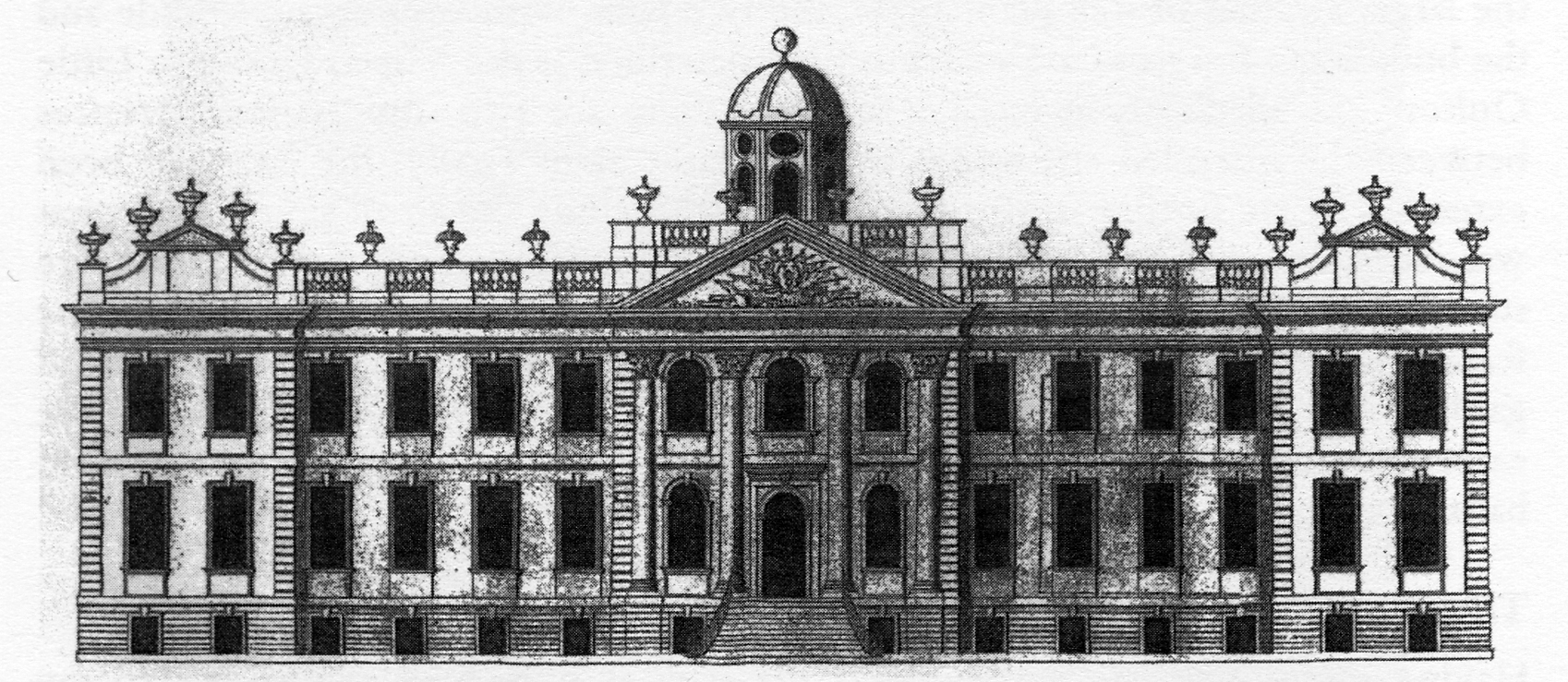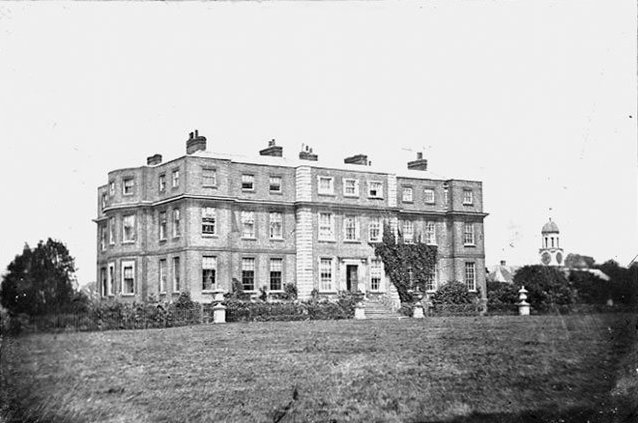|
Francis Haskins Eyles-Stiles
Sir Francis Haskins Eyles-Stiles, 3rd Baronet (died 26 January 1762), formerly Eyles, was a British landowner. He was the only son and heir of Sir John Eyles, 2nd Baronet, by his wife Mary Haskins Stiles. Under the will of his maternal uncle, Benjamin Haskins Styles, of Moor Park, Rickmansworth, Hertfordshire, who died unmarried on 4 April 1739, he assumed the additional name of Stiles after that of Eyles.Cokayne, George Edward (1906) Complete Baronetage'. Volume V. Exeter: W. Pollard & Co. . p. 22 He was elected a Fellow of the Royal Society in 1742, and succeeded to the family baronetcy on 11 March 1745. A few months later, in October 1745, he sold the Gidea Hall estate he had inherited. He was a Commissioner for Victualling, 26 January 1762. He married, probably about 1735, Sibella Egerton (baptised 1 December 1711 at Astbury, Cheshire), daughter of the Rev. Philip Egerton, D.D., Rector of Astbury, by Frances, daughter of John Offley. He died at Naples on 26 January 1762, a ... [...More Info...] [...Related Items...] OR: [Wikipedia] [Google] [Baidu] |
Naples
Naples (; it, Napoli ; nap, Napule ), from grc, Νεάπολις, Neápolis, lit=new city. is the regional capital of Campania and the third-largest city of Italy, after Rome and Milan, with a population of 909,048 within the city's administrative limits as of 2022. Its province-level municipality is the third-most populous metropolitan city in Italy with a population of 3,115,320 residents, and its metropolitan area stretches beyond the boundaries of the city wall for approximately 20 miles. Founded by Greeks in the first millennium BC, Naples is one of the oldest continuously inhabited urban areas in the world. In the eighth century BC, a colony known as Parthenope ( grc, Παρθενόπη) was established on the Pizzofalcone hill. In the sixth century BC, it was refounded as Neápolis. The city was an important part of Magna Graecia, played a major role in the merging of Greek and Roman society, and was a significant cultural centre under the Romans. Naples served a ... [...More Info...] [...Related Items...] OR: [Wikipedia] [Google] [Baidu] |
Baronets In The Baronetage Of Great Britain
A baronet ( or ; abbreviated Bart or Bt) or the female equivalent, a baronetess (, , or ; abbreviation Btss), is the holder of a baronetcy, a hereditary title awarded by the British Crown. The title of baronet is mentioned as early as the 14th century, however in its current usage was created by James I of England in 1611 as a means of raising funds for the crown. A baronetcy is the only British hereditary honour that is not a peerage, with the exception of the Anglo-Irish Black Knights, White Knights, and Green Knights (of whom only the Green Knights are extant). A baronet is addressed as "Sir" (just as is a knight) or "Dame" in the case of a baronetess, but ranks above all knighthoods and damehoods in the order of precedence, except for the Order of the Garter, the Order of the Thistle, and the dormant Order of St Patrick. Baronets are conventionally seen to belong to the lesser nobility, even though William Thoms claims that: The precise quality of this dignity is not ... [...More Info...] [...Related Items...] OR: [Wikipedia] [Google] [Baidu] |
1762 Deaths
Year 176 ( CLXXVI) was a leap year starting on Sunday (link will display the full calendar) of the Julian calendar. At the time, it was known as the Year of the Consulship of Proculus and Aper (or, less frequently, year 929 ''Ab urbe condita''). The denomination 176 for this year has been used since the early medieval period, when the Anno Domini calendar era became the prevalent method in Europe for naming years. Events By place Roman Empire * November 27 – Emperor Marcus Aurelius grants his son Commodus the rank of ''Imperator'', and makes him Supreme Commander of the Roman legions. * December 23 – Marcus Aurelius and Commodus enter Rome after a campaign north of the Alps, and receive a triumph for their victories over the Germanic tribes. * The Equestrian Statue of Marcus Aurelius is made. It is now kept at Museo Capitolini in Rome (approximate date). Births * Fa Zheng, Chinese nobleman and adviser (d. 220) * Liu Bian, Chinese emperor of the Han Dynasty ( ... [...More Info...] [...Related Items...] OR: [Wikipedia] [Google] [Baidu] |
Sir John Grey Egerton, 8th Baronet
Sir John Grey Egerton, 8th Baronet (11 July 1766 – 24 May 1825) was a politician from the Egerton family in Cheshire, England. He was Member of Parliament (MP) for Chester from 1807 to 1818. Born John Egerton, the son of Philip Egerton of Oulton by his cousin, Mary, sister and sole heiress of Sir John Haskin Eyles Styles, 4th Bt.Sir John Grey- Egerton He was educated at and School. He served as |
Oulton Estate
In the early 18th century the Oulton Estate was home to the Egerton family and comprised a manor house and a formal garden surrounded by farmland in Cheshire, England. Later in the century the farmland was converted into a park. The estate is now the site of the motor racing track called Oulton Park. History Grounds In 1731, Philip Egerton (1694–1766) inherited the estate upon the death of his uncle, John Egerton (1656–1731). At that time the estate comprised a house, a formal garden and farmland totalling . Around 1752, Philip Egerton began to construct a brick wall to enclose the estate plus some additional fields, an area totalling . At his death in 1766, Philip was succeeded by his brother John, and then in 1770, by his son Philip (1738–1786). By this time the fashion for formal gardens had been overtaken by the concept of a landscaped garden with surrounding parkland. Philip Egerton commissioned William Emes to plan this for his estate. Emes' plan was prod ... [...More Info...] [...Related Items...] OR: [Wikipedia] [Google] [Baidu] |
St Helen's Bishopsgate
St Helen's Bishopsgate is an Anglican church in London. It is located in Great St Helen's, off Bishopsgate. It is the largest surviving parish church in the City of London. Several notable figures are buried there, and it contains more monuments than any other church in Greater London except Westminster Abbey, hence it is sometimes referred to as the "Westminster Abbey of the City". It was the parish church of William Shakespeare when he lived in the area in the 1590s. It was one of only a few churches in the City of London to survive both the Great Fire of 1666 and the Blitz. Owing to parish consolidation over the years, the parish is now named "St Helen's Bishopsgate with St Andrew Undershaft and St Ethelburga Bishopsgate and St Martin Outwich and St Mary Axe". The Worshipful Company of Merchant Taylors are the patrons of the benefice. Today, it is home to a large congregation in the Conservative evangelicalism in the United Kingdom, conservative evangelical tradition wi ... [...More Info...] [...Related Items...] OR: [Wikipedia] [Google] [Baidu] |
Astbury, Cheshire
Astbury was one of the eight ancient parishes of the Macclesfield Hundred of Cheshire, England. It included two chapelries and ten townships. The chapelry of Congleton was an ancient borough and became a municipal borough in 1835. Under the Poor Law Amendment Act 1886 the townships and chapelries became civil parishes in their own right. Nine of the townships became part of Congleton Rural District in 1894. whereas Eaton became part of Macclesfield Rural District. At the same time, the Chapelry of Buglawton was made an Urban Sanitary District before being abolished in 1936. On its abolition were transferred to Congleton, to Eaton and to North Rode. St. Mary's at Astbury is a large 12th-century church, rebuilt on a unique trapezoidal plan in the 13th and 14th centuries. There is a 14th-century effigy of a knight in the Lady Chapel, and another, possibly earlier, canopied tomb in the churchyard. A fragment of a Saxon cross is built into the exterior wall. Ada, fourth daughter of D ... [...More Info...] [...Related Items...] OR: [Wikipedia] [Google] [Baidu] |
Sir John Eyles, 2nd Baronet
Sir John Eyles, 2nd Baronet (1683 – 11 March 1745) of Gidea Hall in Essex, was a British financier and politician who sat in the House of Commons from 1713 to 1734. He was Lord Mayor of London in 1726. He served as a Director of the East India Company 1710-14 and again 1717-21 and was appointed a sub-governor of the South Sea Company in 1721. Origins Eyles was the second but eldest surviving son of Sir Francis Eyles, 1st Baronet by his wife Elizabeth Ayley, a daughter Richard Ayley, a merchant in the City of London. His younger brother was Joseph Eyles, MP. Career Eyles was a Director of the East India Company from 1710 to 1714. He was elected as Whig Member of Parliament for Chippenham at the 1713 general election. From 1715 to 1717 he was a director of the Bank of England. He was elected MP for Chippenham again at the 1715 general election and voted consistently with the government. He succeeded to his father's baronetcy on 24 May 1716 and became Master of the Haberdashers ... [...More Info...] [...Related Items...] OR: [Wikipedia] [Google] [Baidu] |
Victualling Commissioners
The Commissioners for the Victualling of the Navy, often called the Victualling Commissioners or Victualling Board, was the body responsible under the Navy Board for victualling ships of the British Royal Navy. It oversaw the vast operation of providing naval personnel (140,000 men in 1810) with enough food, drink and supplies to keep them fighting fit, sometimes for months at a time, in whatever part of the globe they might be stationed. It existed from 1683 until 1832 when its function was first replaced by the Department of the Comptroller of Victualling and Transport Services until 1869 then that office was also abolished and replaced by the Victualling Department. History Under Elizabeth I, a General Surveyor of Victuals had been appointed in 1550 a principal officer of the Navy Board to oversee contracts for food and other provisions for the Navy. In 1550 he was listed as one of the seven members of the Board of Principal Officers and Commissioners of the Navy; he was ... [...More Info...] [...Related Items...] OR: [Wikipedia] [Google] [Baidu] |
Gidea Hall
Gidea Hall was a manor house in Gidea Park, the historic parish and Royal liberty of Havering-atte-Bower, whose former area today is part of the north-eastern extremity of Greater London. The first record of Gidea Hall is in 1250, and by 1410 it was in the hands on one Robert Chichele. In 1452 Sir Thomas Cooke (c.1410-1478), a Lord Mayor of London, bought the estate and in 1466 was granted a licence to crenellate, which is a licence for the manor house to be fortified. Gidea Hall was forfeit when Cooke was accused of treason, but he was acquitted and the property recovered after payment of a fine. While work on the manor had started in 1466 with the construction of a moat, they were continued by his son Sir Anthony Cooke, one of whose daughters married Sir Nicholas Bacon and came into possession of the Manor of Marks, another large house in the Liberty of Havering. After his return from exile Cooke entertained Queen Elizabeth I at Gidea Hall during her ''Progress'' in 1568 wh ... [...More Info...] [...Related Items...] OR: [Wikipedia] [Google] [Baidu] |




